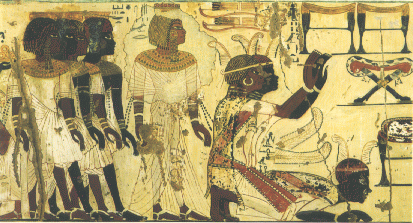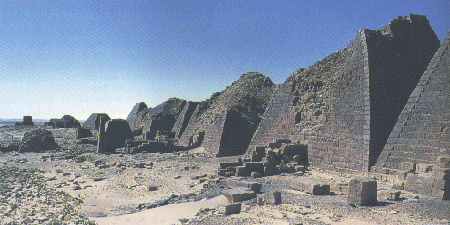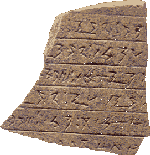
Article Contributed by MAUNFU 9

The land that birthed Egypt is to this day shrouded in mystery. Mainstream historians have continually downplayed the significance of this birthplace of modern civilization. The reality, however, is that Nubia was a land of extraordinary achievement to which we owe all the significant concepts which birthed and nurtured Ancient Egypt.
At the time of the creation of the Egyptian state under King Menes, Nubia was already fully formed. In fact, Menes or Narmer, as he is also known, was from a line of Sudanese Nubian Kings. Afrikan historian Wayne Chandler has pointed out that Menes' unification of Upper and Lower Egypt was the logical result of the Nubian attempt to end disturbances and disorder in the delta region and to bring stability to the entire area. Lower Egypt was not a thriving empire, but populated by bands of Euro-Asiatic nomads whose subjugation and expulsion is commemorated on the historic Narmer's Tablet. The tablet records events leading to the unification of Upper and Lower Egypt. The late Cheikh Anta Diop makes the point regarding this tablet :
".....the person's walking ahead of the Pharaoh and belonging to his victorious army are Nubians, wearing Nubian insignia, such as the symbol of the Jackal and that of the Sparrow-hawk, which we would call Nubian totems.......
The ox-tail carried by the Pharaoh on this tablet, and that Egyptian Pharaohs and priests always carried, is still borne at ceremonies and official functions by Nigerian religious leaders. The same is true of the garment worn by the Pharaoh; the amulet filled sachet on his chest is always present throughout Egyptian history. It is found on the chest of any Negro chief who holds a responsible position; in Wolof, it is called dakk."
Cheikh Anta Diop. The African Origin of Civilization, p 78.
Archaeological work in Nubia has only recently attained notoreiety. There is much yet unearthed and the nature of politics in modern day Sudan is such that Western archaeologists are not given free reign to conduct research wherever they may. This may be all for the better as it is this same Western archaeological establishment which has succeeded in erasing any understanding of the black race of the ancient Egyptians from popular understanding.
The following excerpt is from a cover story from the June 1994 issue of Smithsonian Magazine entitled Out of Africa: The Superb Artwork of Ancient Nubia:
"To the ancient Greeks and Romans, Nubia was one of the foremost civilizations of the world. Because its domain lay on the edge of the unknown south of Egypt, along the tortured cataracts of the upper Nile, where few Greek or Roman travelers had ventured - Nubia shimmered with legend. But there was no mistaking the area's might or wealth.
For centuries, exotic goods had flowed North in an inexhaustible stream from this African font: gold, frankincense, ebony, ivory, panther skins, giraffe tails and hippopotamus teeth. Brave mercenary soldiers, virtuosos of the bow and arrow, also traveled north out of the storied land. Herodotus described Nubians as the "Tallest and handsomest" people in the world, adding that they reputedly lived to an age of 120, thanks to a diet of boiled meat and milk. Roman chronichlers reported that the southern empire was ruled by queens.......Writing in the third century A.D., a romantic biographer of Alexander the Great insisted that in Nubia there were whole temples carved from a single stone, and houses with translucent walls; the queen traveled in a mobile palace on wheels drawn by 20 elephants.
Although these accounts veered into the fabulous, Nubia was no mere fantasm of the poets, no El Dorado. Within Nubia, stretching along the Nile from present day Aswan in Egypt to Khartoum in the Sudan, at least six distinct, supremely accomplished cultures evolved between 3800 B.C. and A.D. 600. Nubian civilization lasted far longer than either classical Greece or Rome.......
Why is it then that most of us today have barely heard of Nubia ?
One reason is semantic. Over millenia, Nubia was known under many different names. To the early Egyptians, it was known as Ta-Seti or Yam or Wawat. Later it appears as Meroe. The Greeks and Romans called it Aethiopia (today's Ethiopia being Abyssinia to them ). In the Bible it appears as Kush.
Another reason has to do with prejudice. Nubia has always been exceedingly remote and difficult to access. From its Christianization in the 6th century A.D. all the way down to the 19th, the kingdom vanished from the European record: only the glowing reports of the classical authors kept it alive. This neglect had everything to do with race - for Nubia had been an African empire, and a black African one at that. Even the Greeks perpetrated the prejudice. An early biographer of Alexander the Great records the queen of Nubia responding to a letter from the youthful conqueror with the following words: "Do not despise us for the color of our skin. In our souls, we are brighter than the whitest of your people."
The first archaeologists to document the glory that was Nubia succumbed to a kindred bias. Even as he dug the remarkable royal cemeteries of El Kurru below the Fourth Cataract, George A. Reisner, working for Harvard University and the Boston Museum of Fine Arts, concluded that the rulers whose tombs he unearthed must havwe been an offshoot of a dynasty of Libyan ( thus whiteskinned ) pharaohs. For decades, everything Nubian was regarded as derived from the Egyptian, hence "decadent" and "peripheral."
Yet, in Sudan, a French survey has counted one million ancient mounds, only a fraction of which have been excavated. There are more royal pyramids in the Sudan than in all of Egypt..........
After 1700 B.C., racked by internal struggles, Egypt retreated from Nubia, abandoning its fortresses along the Belly of the Rocks. In the void, [ the Nubian city of ] Kerma grew magnificently. Nothing declares the flamboyant, even grandiose glory of Kerma more forcefully than its royal tombs. The king was buried under a huge tumulus - a circular mound with the diameter nearly the length of a football field. He was laid on a gold covered bed and the finest objects wrought of gold, bronze, ivory and faience were placed beside him......

At Kerma, however, for the past 28 years an international team under Charles Bonnet, of the University of Geneva, has quarried out one of the most ambitious digs in Africa. In the process, they have revealed not only the palaces and cemeteries, but the main town of Kerma.....Bonnet's work documents the oldest city that has ever been found in Africa outside Egypt."
We may date these as follows:
A Group.................. 3800 - 2900 BC
C Group.................. 2300 - 1550 BC
X Group...( Napata ) 900 - 300 BC
...............( Meroe ) 300 BC - 500 AD
THE A GROUP
The first recognizeable Nubian civilization emerges circa 3800 BC. This is the kingdom known as Ta-Seti ( the Land of the Bow ) by the Egyptians. Its capital was at Qustul where a large cemetery wherein are buried its monarchs has been unearthed. Known as cemetery L, it contains impressive artifacts illustrating the wealth, complexity and advancement of the A Group peoples. Typically, mainstream archaeology has systematically misread and dismissed many of these artifacts in an attempt to portray this culture as subservient to Egypt.
Dr Ivan Van Sertima of Rutgers University writes in Blacks in Science: Ancient and Modern, p 24 :
"Most of us have heard of Meroitic script invented by the Nubians and partly influenced by the Egyptians. But what is far less known and far more important is the discovery, announced 4 years ago, that the origin of the Egyptian hieroglyphic system itself lies among black people in the Sudan. On March 1, 1979, this discovery made front page news in the New York Times. Dr. Bruce Williams, a research associate of the Oriental Institute, University of Chicago, announced the discovery of a black kingdom, known as Ta-Seti, at a place called Qustul, which preceded the First Dynasty in Egypt by 12 generations. About a dozen black kings reigned at Ta-Seti and all the major religious and political symbols of a later Egypt were found in this kingdom, the very first in the Nile Valley. On a stone incense burner dated 3,300 B.C. were carvings of the falcon-god Horus, the uniquely-shaped crown that was to adorn the later Egyptian kings, the sacred boat-litter of the pharaohs, the elaborate palace serekhs and facades - everything already in place among these royal blacks. Most important, the excavators found inscriptions - the earliest in the hieroglyphic system - in the tombs of Qustul, a system that was not only to be the mother of the Egyptian but was to have a seminal effect upon some European writing systems as well. "
<< Anteriority of Nubian Civilization:
"We have written in Nations Negres et Culture and in our later publications that, according to the quasi-unanimous testimony of the ancients, Nubian civilization preceded and might have even given birth to that of Egypt. This is quite logical if one considers the likelihood that the Nile Valley was peopled by a progressive descent of the Black peoples from the region of the Great Lakes, the cradle of Home sapiens sapiens. ........proof is now established that Nubian monarchy is the oldest in the history of humanity. We thus better understand the matriarchal nature of Egyptian royalty and the importance of the role of the queen-mother in Nubia, Egypt and the rest of Black Africa.
The woman, the queen, was the true sovereign, the keeper of the royalty and the guardian of the purity of the lineage. To this end, it often happened that she married her brother or her half-brother by the same father: it was she who transmitted the crown to her husband, who was only her executive agent.
In Wolof, a Senegalese language, the word "sat" (grandson, descent) is an ancient forgotten feminine form. Indeed, "sat" = daughter in Egyptian; thus, originally, the Wolof word, it seems, exclusively designated uterine descent through daughters. More precisely, in ancient Egyptian, "sent" = sister; in Wolof, "sant" = the proper name of a clan, which perpetuates the familly line and is that of the mother, in other words the sister of the uncle in a matrilineal system: it is through the sister that rights are transmitted and the "race" is perpetuated. According to Ibn Battuta, in 14th century Mali, men were not named after their fathers: "None of them [ the men ] is named after his father, but each traces his genealogy through that of his maternal uncle. Inheritance is collected by the sons of the sister of the deceased, to the exclusion of his own children."......
We also understand better now why the Egyptian term designating royalty etymologically means: (the man) "who comes from the South" = NSW < N Y SWT = who belongs to the south = who is a native of the south = the king of Egypt, NOT ONLY the king of Upper Egypt. Whereas "Biti" = the king of Lower Egypt and has never meant just king. In other words, the king of Upper and Lower Egypt, king of all Egypt. (Note that Upper Egypt is geographically to the South and Lower Egypt is geogaphically to the north nearer the Mediterranean sea. 'Upper and Lower' designate land elevation, not latitude).
Now we understand better why the Egyptian turns toward the South, the heart of Africa, land of his origins, land of his ancestors, "land of the Gods", just as the moslem today turns towards Mecca. This is why the right hand designates the West and the left hand the East. It is not, as Edouard Naville assumed, due to a march toward the south, supposing a northern origin of the ancient Egyptians.. The Egyptian gods themselves, the god Min, in particular, were making this symbolic return to the South; the god was taken out and carried for some time toward the South, and then he was returned to his sanctuary."
It is important to understand the significance of Nubia to Egypt. The ancient Egyptians not only understood Nubia to be their country of origin, but they considered the South to be the birthplace of their Gods. The actual tomb of Osiris is at Edfu in Nubia.
THE C GROUP
As the C Group emerges as a cultural force, another empire develops simultaneously. This is known as the Kerma culture and dates from 2400 BC approximately. The civilization is named after the fabled city it centered around. Along with other centers, the entire empire became known as the Kingdom of Kush.
This C Group proper begins around 2300 B.C. as the Kingdom emerges a little above the second Cataract of the Nile. Its major cities included Aniba and Dakka and it maintained consistent relations with Egypt from the end of the Old Kingdom through the New Kingdom.
Eventually, the C Group was swallowed up by the expanding state of Kush now in full bloom. The burial sites and monuments of the monarchs of Kerma are impressive indeed. It is this empire which is the catalyst for the expulsion of the Asiatic Hyksos from Egypt, the establishment of the impressive Seventeenth Dynasty of Kimet and the magnificent 18th Dynasty under Ahmosi and his celebrated queen Ahmose-Nefertari.
THE X GROUP
The two most significant civilizations of the X Group are defined by their capital cities. The first is Kingdom of Napata.
The second is Kingdom of Meroe.
NAPATA
Napata is best known historically as the land from which came the Pharaohs of Egypt's Dynasty XXV also known as the Kushitic Dynasty. The first recognized King of this era is Alara. In reality, however, he was the latest in a line of Kings at least four generations active. In the face of the encroachment of Assyrian power and the disintegration of Egyptian society in the North, it was once again the Nubians down south who came to their neighbor's aid. Begining with Kashta, the son of Alara, Nubia began the reunification of Kimet which would be completed by the brilliant general and Pharaoh Piankhi. After sacking Thebes in his march northward, Piankhi laid siege to Memphis, leading his army himself and liberating the city before uniting the entire Nile Valley under his rule. The succeeding Nubian Pharaohs were no less distinguished. Shabaka and Taharqua began a rennaissance of Egyptian culture based on its origins in Nubia which is obvious to this day in written documents and surviving monuments.
MEROE
With the fall of Kimet to Persia and then to the Macedonians under Alexander the Great, the end of Black control of the Nile Delta was now a reality Nubian Africa had to contemplate. The ramifications of this reality were obvious and the Nubian monarchs of Meroe decided to move their capital south deeper into the heart of the continent. This capital now became Meroe ( pronounced Mer-oh-way ). Meroe is still virtually untouched by archaeology. An immense amount of knowledge will be gained by its excavation in modern day Sudan.

Meroitic culture was quite splendid, developing unique aspects distinct from what had come before in Nubia and in Egypt as well. Attempts have been made to decipher its unique script, but there has been no official word of the success of this endeavor. By this time, in Nubia, a number of Kandakes had now ruled specifically as Queens rather than the customary Queenmother. Their heroic feats and accomplishments have consistently been the stuff of legend.